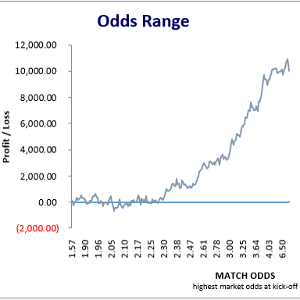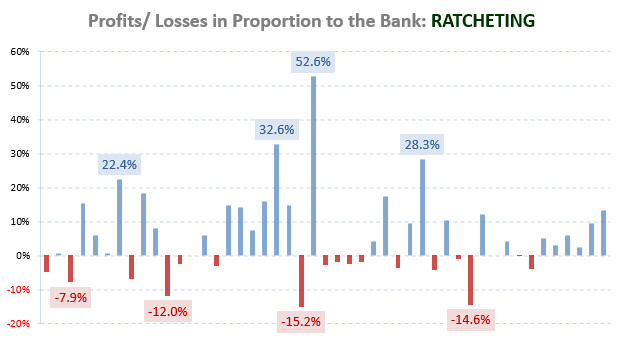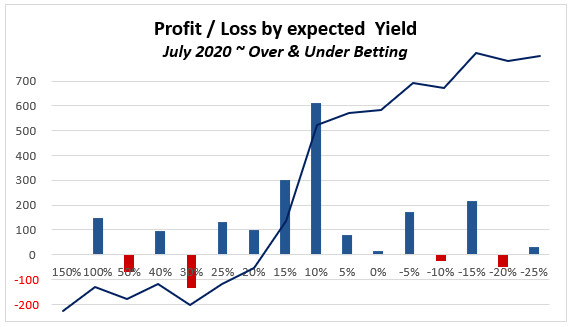
Chrono Tab
Hopefully this tab is fairly self-explanatory. The most important thing in it is the winning and losing streak history.
As mentioned previously, the synergy of many systems performing together dilutes the longest losing streaks possible in any single system. The worst streaks experienced were a couple of sequences of 10 lost bets in a row. Some of the predictions had warned against runs of 12, 14 or 15 losses in some systems on a stand-alone basis (Column P in the Summary tab).
A few more notes:
- Days of the week or months of the year – no need to feel superstitious. It really doesn’t matter which days betting takes place on. The key is to bet on every match which fulfils the requirements of each system without missing any (which is an achievement in itself).
- There was a greater prevalence of losing rounds towards the end of the season (five of the last eight rounds were losers). As leagues began finishing, the number of games available to bet on dropped. A small number of bets is always vulnerable to even tiny deviations from expected results.
- The campaign could have been wound-up after round 33 and finished £700 richer without having to place another 90 or so bets, but this is purely with the benefit of hindsight. Every season is different. Ideally, each system within your portfolio should be seen through to a conclusion.
Inflection Points Tab
A cursory look at the graph will probably convince a lot of people that there is no need to bet on anything with odds lower than 2.28: The same profit could have been achieved with 320 fewer bets.
This is another comment easier said with hindsight and to exclude bets under 2.28 would interfere with the synergy approach. It’s the big odds that do the damage and earn the money – here, the away wins and underdogs. (And draws when you have them in your portfolio).
It’s the smaller odds for home wins and favourites (usually the home team) that ‘fill in the gaps’ between the fewer wins at higher odds (and lower probabilities).
The winners at lower odds claw back the losses from the lower probability losing bets and keep the losing streaks as low as possible. Their primary job is to support the higher risk systems – it’s icing on the cake if they make a profit in addition.
If concentrating only on away wins and underdogs the losing streaks would be longer, a bigger bankroll would be needed to cope with them, and nerves would be more frayed waiting for those big ones to come in and save the situation.
It is better to place more bets, instantly forget about them, and go down the beach for a walk knowing that the profit/loss curve is going to be a much smoother ride than the rollercoaster of jagged peaks and troughs characteristic of a high risk/high profit curve. But everyone will have their own opinion on this.
A good blend of low odds/low risk and high odds/high risk bets therefore provides for a much smoother investment experience. This spread of risk concept is also the business model adhered to by bookmakers, insurance companies, reinsurance companies, etc.
The Inflection Points graph is excellent at underlining the fact that backing only short priced home wins and favourites is exactly what the bookmakers want you to do. The graph clearly shows a zero-sum game up to odds of 2.28 and this is, of course, after cherry-picking the sweet spot in each league. A sobering thought.
Coloured System Tabs
Above the break in each of these tabs is a summary of the exact system formulated from the HDAFU tables. It has literally been just copied and pasted from the table to the monitoring sheet.
See the HDAFU User Guide on how to select systems from the HDAFU tables.
Conclusion
Ultimately, spending time researching and thinking about endless variables such as team news, form, league position, the weather, the officials, etc., becomes a redundant occupation.
How is it even possible to come up with a universal algorithm to take into account every extraneous factor affecting a football match before a ball is kicked, and futureproof it to include the unforeseen events of the game itself? It’s impossible for most people to comprehend, and that’s why bookmakers exist.
This is why the HDAFU tables use the same approach as the bookmakers. After all, it’s only a numbers game and that’s all you need to work with. If every match had been analysed individually, the analysis would still be going on now, let alone leaving enough time to place 825 bets.
In short, the entire project consisted of compiling the HDAFU tables, looking at the inflection points for promising trends, filtering the results to find the best systems, and then placing the bets using Oddsportal.com as the ante post odds benchmark.
Performance was monitored as the campaign unfolded and, lastly, the post mortem was carried out. Nothing else. Not a single look at the league table in any of the leagues, and bets placed usually with no idea about any of the teams involved. Every bet was accepted and no bookmaker accounts were closed or limited. From top to bottom, a very clean and methodical exercise.
Improvements for the new season will see a couple of stake management tweaks: a stop-loss mechanism (reducing stakes in a particular system if losses reach a certain point); a ratchet system (increasing stakes progressively as new bankroll growth targets are met). These will make the most of the bankroll and compensate for those occasions where bets are placed below the best odds available in the market (on the winning bets).
As for Summer League portfolio size, bigger is always better. If you do wish to buy HDAFU tables, a set of systems across several leagues that is going to provide you with at least 500 bets in a season is recommended.
Running parallel summer and winter league systems adds another level of synergy to the whole process.
Lastly, it is important to reiterate that what was viable in one season is not necessarily ‘sound’ in the following season. Every league has to be updated with the new season’s data, whilst the fifth-season-back drops out of the data pool.
Some of the same bet types may be viable from one season to the next but the odds parameters change every season. Please therefore do not rely on these 2016 results to place bets in future seasons – sorry, but it’s just not going to work…






Hi, I’m just wondering if a portfolio made up of various systems selected properly as you explained may end up with an actual negative yield…did it ever happen to you?
Thank you and congratulations for the great website!
Hi Mark, although normally it shouldn’t you can never say never.
Targetting the sweet point in the odds using the HDAFU Tables you are targetting low probabilities and I’m sure that you experienced in your life probably even more than once that, when you were throwing a dice (16.67% probability for a ‘1’, for example) that you had to wait for 20 (or even more) rounds until the first ‘1’ was thrown. It probably happened to you only once in your life but certainly not ‘never’. In that case, you may have experienced a ‘negative yield’ should you have included the ‘1’ in your portfolio of bets.
Hope that makes sense.
Hello again Jamie,
I can’t teach you how to use Excel, but the cluster sizes are determined by Excel’s maximum number of 200 reference points for producing graphs.
This is a limitation that has always been a barrier in Excel, thus we can only produce 200 “clusters” in any one table.
To be honest, it doesn’t make much difference: 200 clusters is plenty, and you will see that some odds account for multiple numbers of clusters – e.g. draw odds of 3.40 might account for several clusters of their own, whilst odds of 1.06 to 1.10 might be contained in a single cluster.
Even if you could change it in Excel, it wouldn’t make much difference – you are still able to fine tune the results by looking at the data tab to determine where the profitable ends of the inflection points graph start (see the User Guide).
Be sure to read the comments in the Winter League summary, which also contain a mine of useful hints and tips.
Hi,
How do you pick the clusters that you want to use, is there a methodology behind it? I have purchased the Netherlands HDAFU tables but was wondering why they are set the way they are and the thinking behind it.
Hi Jamie,
I’m not sure what you are referring to precisely?
Do you mean the Inflection Points graph itself, or choosing which systems to go with that are highlighted by the graph?
I am referring to the cluster sizes. How do you set them or decide on them? How do you group them and work them out and could this be changed or would it matter?
I can suggest to have a look at Sportmarket Pro. It’s a multiplatform broker like Vodds that includes exchanges like Betfair at 2.5% fixed commisison, Betdaq at 1.2% fixed commission and Matchbook at 1.8% fixed commission ON WINNING BETS only, instead of every bet (winning and losing) like betting on Matchbook website. They also have Pinnacle, SBOBET, and all the major asian bookies. I used them for almost a year now and they are very professional and fast in their withdrawals also. Definitely check it out!
Hello again Tim,
Well, one of our accounts is Smarkets, whose commission rate is 2%, so we do use exchanges ourselves.
Of course, if you wish to use Betfair, then their 5% commission rate will certainly take a chunk of your profits away.
However, the system should still work – it just won’t earn you as much profit…
Do you think this would work using only an exchange – betfair – for placing bets?
Regards
Tim
Hi
What was your starting bank for this cycle with £100 per bet?
Regards
T
Hi Tim,
When we began the 2016 Summer League campaign, we started off with £2,000 in various accounts.
But the official bank size on paper was set arbitrarily at £1,500 to cope with the longest possible losing streak of any one system. Our analysis showed this was 15 losing bets in a row in the Japanese J-League away win strategy.
I say ‘arbitrarily’ because we never expected to lose 15 bets in a row with all the systems overlapping and supporting one another.
Thanks for your question.
Hi! Congrats on articles!
I have a tricky question: what happens if “a lot of users” start to use these methods at the same time, finding the same spots for an eventual profit? Wouldn’t these strategies start to become obsolete?
Thanks!
Hi Gabriel,
Firstly, we are not giving away systems – merely the tools for individuals to decide upon their own strategies.
As mentioned in the articles, everyone has their own levels of acceptable risk and, therefore, each person’s portfolio of chosen systems and bets will be different from the next person’s.
Add to this the facts that each punter will be playing with different levels of stakes and have access to different sets of bookmaker and/or betting exchange accounts.
Also, one person may not be as disciplined as another regarding the placement of every betting opportunity.
Therefore, I would say that it is highly unlikely that you will see any noticeable betting patterns affecting the market as a result of any systems being followed by Soccerwidow readers.
Right Winger,
let’s suppose for a match on the HDAFU analysis two teams have the same odds. How do you ensure the correct calculations when the system have to count favourites and underdogs? How can Excel manage to understand which one is the real favourite? Maybe you just shorten one of the two by a 0.01 to achieve this purpose?
Hello again Daniele,
If you’re using Oddsportal to check the odds, and the highest odds are the same for both teams, use the Average Odds as a tie-break.
Whichever team has the higher average odds, make them the underdog, and vice versa.
I have never seen a match where the highest odds are the same as each other, and where the average odds are the same as each other.
For the sake of the HDAFU tables, we do occasionally increase the underdog odds by one tick as you suggest, but this happens so rarely that it should not be a statistical concern at all.
Hope this helps.
Hi Right Winger!
How do you split the seasons for the mid-season break? Some seasons have their holiday breaks before the official closing of the first round of games (for example, although this changed in this year, the Italian Serie A had their holiday break just before Christmas, until around a week in the beginning of January, but the first round of games was finishing only one week later. So how do you choose when to split the season in a case like this? Is it on the longer holiday break, making the two halfs slightly different in terms of length, or just the official end of the round?
Thanks in advance for your reply
Hi Daniel,
Yes, it’s the holiday break – sometimes the two halves of a season do differ in length, but only by a few games and this is not likely to have much statistical significance on the results.
We split wherever the ‘clean break’ is in the middle of a season.
Hello Jo,
Marathonbet and 1x2bet seem to be so similar in their odds setting that it is difficult to see that they are not connected in some way. There must be some common denominator connecting both bookmakers (apart from the fact they are both Russian).
My advice regarding the fluctuations in prices between these two and the rest of the market is to trust the majority as your guide. If the indication of the majority is within your inflection points, but you can get a higher price with Marathonbet or 1x2bet, then place the bet at best price with either of these two.
But be careful, we have experienced situations where, although the prices on their sites are indeed well above the crowd, stakes are sometimes limited.
This is just a method of attracting ‘quick’ money to help them balance their books, which is essential practise for low margin bookmakers of this nature.
I am preparing a paper on odds movements throughout the ante post market, which should be available later this year. It will be a vital addition to your knowledge.
Hi Right winger,
I encountered one problem with Marathonbet a few times and will probably have it in the future. The problem is: I check odds in the Oddsportal on the outcomes having potential to bet on, 1 hour before kick off time odds are quite above my top (or below) inflection point I have to bet on across all bookmakers Oddsportal provides. But less than an hour before kick off time odds dropped significantly across all bookmakers except Marathonbet. Odds provided by all remaining bookmakers dropped within my inflection points with an exception of Marathonbet (and sometimes 1xbet is also slow to follow the market). They lower their odds just 0.2 or so during the last hour, while others move their odds down 0.5-0.6 or so. And if odds at Marathonbet are 4.3 and the rest of the bookmakers have 3.8-3.9. I would say Marathonbet is quite off line and what confuses me the most, these odds are available in their site to bet on, so it’s not Oddsportal fault. If my inflection points are between 3-4 should I care about Marahonbet odds or remaining bookmaker odds considering are the odds within my inflection points or not?
Just wondering what would happen next season in terms of updates, do you provide instructions on how to update the tables or would I be required to buy new updated tables?
Hi Jamie,
Updating the tables each season is a major task. You also need reliable historical odds representative of a certain period in time in order to use the tables most effectively.
We also upgrade the tables each season with improvements or extra features.
We are therefore sorry that we cannot provide a user manual for people to upgrade the tables themselves. Besides, in terms of the the time it would take to perform such an exercise, it is probably cheaper for our customers to buy the newest versions.
The updated Winter League tables will be available in late May, early June, when the 2016-17 seasons have ended.
Thank you
Hi Right Winger!
You said you use the highest closed odds. Its Ok, but my question is: Which bookmakers’ odds? Because on the page Oddsportal there are many soft and small bookmakers for example 1xbet, Marathonbet, Tempobet etc.. who give the highest odds on the market. Why?
Because the are very slow and they can not follow quickly the oddsmoving.
Also I would like to know, from which bookmakers odds do you choose when you make the HDAFU tables?
Thank you!
Hi Attila,
Thanks for your comment.
Yes, we use Oddsportal odds but we are also aware of the technical glitches they have.
Indeed, all sites using API’s to record odds at specific times have problems.
Certain bookmakers on Oddsportal do not update properly. This can create a situation where a firm’s opening odds never update and end up appearing as their closing odds too. They then stick out like a sore thumb in comparison to the closing odds of others around them.
Because of this, Oddsportal highest odds at close of the ante post market need to be checked for accuracy. When recording them we use over-round calculations as an indicator of anything that needs to be double-checked.
Getting accurate odds representative of any one moment in time during the ante post market is the biggest challenge for anyone when compiling data for analysis.
We have no choice but to use Oddsportal’s compulsory set of 20 bookmakers or so, added to which, are another 10 of the larger, more reliable firms. Our personal portfolio is therefore around 30 bookmakers.
Many of the problems are caused by Oddsportal’s compulsory list. Problem bookmakers here include Tempobet, Marathonbet, Titanbet, Boylesports, William Hill, to name but a few.
Contrary to your point about odds moving slowly, I would disagree as no bookmaker wishes to remain with the highest odds on any outcome for any great length of time. They need to keep their books balanced and will dip in and out of the market according to the weight of money they receive from the punters.
If any one bookmaker were to offer best price some way ahead of its rivals, then it would see a lot of money placed on that outcome as punters shop for the highest price. Receiving a flood of money on one outcome leads to more difficulty balancing the other outcomes.
Low margin bookmakers (e.g. Pinnacle, Marathonbet) rarely offer best price on the favourites – more usual practice is bigger prices on the more unlikely outcomes.
It is always educational to watch a site like Pinnacle and see how often their prices move – sometimes several times a minute on the more popular games. Compare this with betting exchanges where prices also fluctuate from minute to minute. Of course, betting exchange prices are influenced and led by the bookmaker prices – if this was not the case, we would all be rich, successful and professional arbitrageurs!